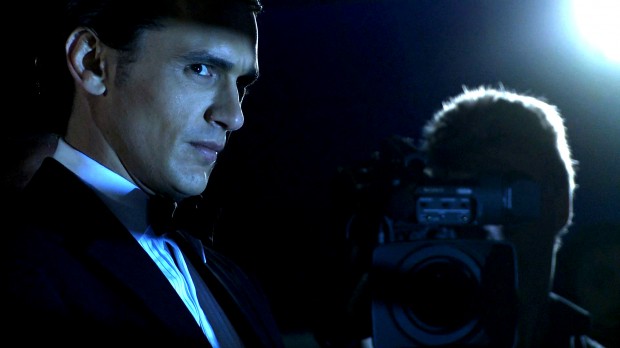 It would be a shock to discover someone, from either the third-world or the super-consumer world, that doesn’t know who James Franco is.
It would be a shock to discover someone, from either the third-world or the super-consumer world, that doesn’t know who James Franco is.
Just from starring in the TV-cult-hit “Freaks and Geeks,†to winning a Golden Globe for his lead in the biopic “James Dean,†Franco is a pop culture idol of sorts, but after his performance as Harry Osborn in Sam Raimi’s “Spider-Man†trilogy, and his performance as Aron Ralston in Danny Boyle’s drama “127 Hours,†he’s a bonafide heartthrob.
Then one morning we found Franco back on television, unexpectedly, on the daytime cathedral “General Hospital.â€
Now he’s this generation’s Kevin Bacon.
On General Hospital, he plays a crazed installation artist-serial-killer named Franco. Both the actor and his character, stars in the playful, experimental, but galling documentary, “Francophrenia: (or: Don’t Kill Me, I Know Where the Baby Is).â€
In substance, the film is composed primarily of a group of cameras that followed Franco around on a special episode of “General Hospital†that was shot on location at the Museum of Contemporary Arts, Los Angeles. The cameras captured over forty-hours of high-definition video, months before Franco and the prominent documentary director, Ian Old (“Fixer: The Taking of Ajmal Naqshbandiâ€), got together to turn it all into something different.
Mission accomplished.
Olds takes the hours of footage of Franco—in his dressing room, running up and down the maze of hallways inside MoCA, signing autographs to fans, rehearsing, waiting, taking breaks and naps, finally some acting, and then more sitting around before the director calls it a day—and turns it all into a walkthrough from the inner workings of the immortal daytime soap opera.
Early on co-directors Olds and Franco reveal the nature of modern celebrity-worship. After he leaves his dressing room, Franco walks toward the hundreds of fans excitedly calling his name, holding up posters of his face, a sea of cameras and camera phones that burst in flashes, each claiming their own piece of Franco.
As hundreds swarm around him, “James can I get an autograph,†“Can I get a picture of us together,†Franco seems unfazed. Equipped with the same smile, he is like a Madame Tussaud’s wax figure, ready to please, the perfect photo-op for the social networked masses.
Unfortunately, one can only sit through so much of the stoic, carved, and laconic actor. Thus, in a monumental effort to keep our A.D.D. attention, Olds and his writing partner Paul Felten inserts comedic voice-overs to Franco’s Derek Zoolander pouts and stares. So, just as our patience is reached a handful of cartoony voices—one for Franco, and a voice for each of the two stencil figures found on a bathroom door—acts as lifesavers for our drowning sanity.
The comedic lines get the job done, but they become laugh out loud hilarious from the desperate painful pleas for something else, anything else, than the wordless frame saturation of Franco’s face. It doesn’t take long for the novelty of behind the scenes action to wear off and the trippy voices, greatly helps one reach the end.
The episode of the soap opera filmed in “Francophrenia†was never aired. But the full episode is spliced into this film. The scenes are presented with a creative funky filter to chalky outlines that it’s actually a strain to follow the episode.
After seventy-minutes, a shocking statistic as the movie will feel so much longer, one will either walk away with a new appreciation for the tremendous amount of work that goes into the making of a television show, or experience that wonderful scene from “Being John Malkovich†where everyone is a Malkovich.
Except that it’s not Malkovich. It’s all Franco, everywhere.

Leave a Reply